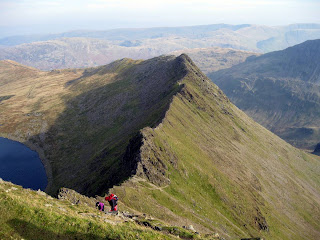At 950 metres, Helvellyn is not the highest peak in the country (two others being a few metres higher), but there can be little doubt that the view from the top of Striding Edge is among the most spectacular scenes.
Striding Edge is more than a mile long. It is one of those geographical features that used to be in every child's text books. Perhaps it still is, but the kids that I have asked have not responded positively. (Hardly a surprise there!) That could be for a number of reasons, but putting on a curmudgeonly hat (for a change) I think it is because young people today seem generally less impressed by the natural wonders around them than they are by whatever nonsense their friends are putting on Facebook. That's a tragedy isn't it?
The reason for its appearance in text books is that it is a feature produced by glaciation. During the last ice age when Britain was overwhelmed, several glaciers started from the top of Helvellyn, pouring themselves down the mountain in a leisurely way. The one between the two 'knife-edge ridges', Striding Edge and Swirral Edge produced a 'cwm' which is now partly filled by the pretty little Red Tarn.
Aside from the technical details, I was accompanied by two teenagers to the mountain and we traversed Striding Edge in a strong gale and then clambered up the even more frightening climb to the top of the mountain. Of course they took it in their stride much more than I did. I have never been afraid of heights, but I must admit that a slight feeling of vertigo was threatening me at several points on the windy climb up the mountain.
I'm sure that Helvellyn is higher than it was 30 years ago! And steeper! At least this time I did not have a snow-drift building up in my ear! The temperature was perfect for walking/clambering, and the decision to wear shorts for the walk was not regretted at any point - or at least not by me!
The journey down from the peak would have been less exciting if it had not been for the wind. I can't even begin to estimate the speed of the wind, but on the long wide slopes to the north of the peak of Helvellyn, the cross-wind threatened to blow me off my feet several times.
I found myself very glad that I had bought a pair of light weight walking poles. Not only had they helped to share the load between arms and legs on the way up and down, but they helped to counter the force of the wind. (They also helped me to realise that certain muscles in my arms had not been used enough! Ouch the following day!)
One item of reassurance was gleaned from the 11 mile walk, with 3,500 feet up and down. Sorry about the archaic units, but they worked well in the version of 'Naismith's Rule' that I had been taught years ago. (This is a rule which helps you to calculate the amount of time needed for a walk.) I had expected that a correction factor much greater than unity would have to be applied for unfit men of my age, but nobody could be more surprised than me that the 5 hour 45 minute walk was completed a few minutes faster than the calculation would have predicted.
Looking at the Wikipedia entry about Naismith's Rule I find the answer less reassuring - but probably more realistic.
Finishing on a lighter note, did you know that Helvellyn is a 'Marilyn'? This is a term for a peak that is 150 metres higher than its surroundings. The name is a pun on the Scottish Munroes (Marilyn being homophonous with Munro).

No comments:
Post a Comment